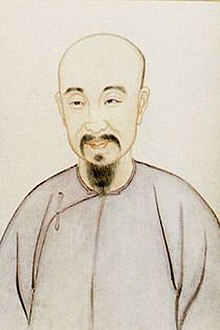Kong Shangren
Kong Shangren ( Chinese 孔尚任 , Pinyin Kǒng Shàngrèn , W.-G. K'ung Shang-jen ; born 1648 in Qufu ; died 1718 there ) was a Chinese poet of the Qing dynasty .
Life
Kong was a 64th generation descendant of Confucius and a scholar according to family tradition. He was a writer and collector of ancient writings, particularly on history, ceremonies and music. During a visit by Emperor Kangxi to the Kong family residence in Qufu, he impressed the ruler and was called to Beijing as a scholar and official in 1685 , where he also taught at the Guozijian .
Although his earlier works also exist, including the two history games Xiao Hulei and Da Hulei ( Small and Large Lute ), Kong Shangren's main work is considered to be his historical play The Peach Blossom Fan , which he published in 1699 after more than a decade of processing. In 1700 he gave up all his offices and from 1703 onwards he spent his retirement years in Qufu without continuing to be literary. This gave rise to controversial speculation that he was relieved of his offices due to his highly political success - although it mourned the Ming dynasty that had fallen a few decades earlier , it became a favorite of Emperor Kangxi himself. It was already popularly performed in 1700 and has also been adapted and filmed several times.
The peach blossom fan
The play Táohuā shàn ( Chinese 桃花 扇 , Pinyin Táohuā shàn , W.-G. T'ao-hua shan , German: peach blossom fan ) depicts the circumstances of the fall of the Southern Ming at the short-lived court of Emperor Hongguang in 44 scenes and with 30 main roles (Term of office 1644/45, also: Zhu Yousong) in Nanjing from 1643 to 1648. The central figures are the lovers Hou Fangyu and Li Xiangjun , whose romance is ultimately doomed to failure. Loyalist references are made to the heyday of the earlier Ming dynasty, which perished due to the selfish and short-sighted decisions of the competing groups at court. The historical roles are portrayed morally complex. The eponymous fan is splashed with the blood of the heroine Li during a suicide attempt - the resulting red image is subsequently transformed into a flower motif. The representation and organization of all figures follows philosophical ( Confucian as well as Taoist ) considerations, a complex division into different and partly overlapping classification systems as well as contemporary clichés .
literature
- Richard E. Strassberg: The World of K'ung Shang-Jen: A Man of Letters in Early Ch'ing China. Columbia University Press 1983. ISBN 9780231055307 .
- Wolfgang Kubin: History of Chinese Literature. Volume 6: The traditional Chinese theater: from Mongolian drama to Beijing opera . Munich 2009. pp. 246-256. ISBN 978-3-598-24543-5 .
| personal data | |
|---|---|
| SURNAME | Kong Shangren |
| ALTERNATIVE NAMES | K'ung Shang-jen |
| BRIEF DESCRIPTION | Chinese poet and scholar |
| DATE OF BIRTH | 1648 |
| PLACE OF BIRTH | Qufu |
| DATE OF DEATH | 1718 |
| Place of death | Qufu |
